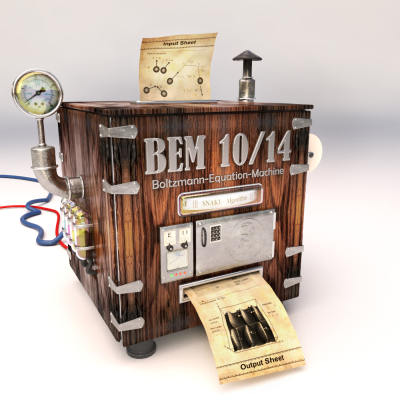Numerical Treatment of the Boltzmann Equation for Self-Propelled Particle Systems
Florian Thüroff, Christoph A. Weber, Erwin Frey
In the second half of the 19th century, Ludwig Boltzmann took a major leap to reconcile two apparently disparate notions, to capture the physics of gaseous systems: the atomistic and the hydrodynamic paradigms. The atomistic paradigm addresses many-particle systems whose physical properties are determined on the basis of the dynamics of the system's constituent particles. The hydrodynamic paradigm, on the other hand, addresses continuous systems whose physical properties are captured by a set of phenomenological kinetic coefficients. In 1872, Boltzmann's ideas culminated in a remarkable equation of motion for the one-particle distribution, which today bears the name of his inventor. The Boltzmann equation incorporates a particle-level description of binary interactions and lends itself to the derivation of a hydrodynamic description of gaseous systems, thereby connecting the macroscopic kinetic coefficients to the microphysics of particle interactions.
In modern research, a new class of gaseous systems, so-called active gases arouses the interest of many scientists. Unlike gas molecules at thermal equilibrium, the constituent particles of active gases are self-propelled, and mutual interactions are typically highly dissipative. Such systems are far from thermal equilibrium and exhibit a wealth of patterns on macroscopic scales, which ultimately arise as a consequence of activity and dissipation at the microscopic level. Its distinctive capabilities to mediate between the microscopic and macroscopic views on physical systems therefore makes the Boltzmann equation a conceptually highly appealing tool in understanding the unusual collective dynamics of such active systems.
Unfortunately, the rather complex mathematical structure of the Boltzmann equation makes it difficult to successfully implement the aforementioned mediation strategy. Previous approaches to assess the macroscopic dynamics of specific active systems largely rely on expansion techniques which substantially limit the range of applicability of the ensuing hydrodynamic equations. In our work, we propose an alternative approach to solve the Boltzmann equation numerically. The computation scheme we developed allows us to study parameter regions even well beyond the onset of collective phenomena and, in addition, provides a highly flexible means to investigate spatially confined systems with arbitrary boundary geometries.
We apply our numerical method to investigate an archetypical model system of self-propelled particles, which can be considered as an active counterpart of the two-domensional XY model. Our studies reveal striking similarities between the ordering transition in this active model system and the liquid-gas phase transitions in equilibrium fluids. Moreover, we observe a novel stable limit-cycle solution of the Boltzmann equation, which consists of parallel lanes of polar clusters, moving in opposite directions.


